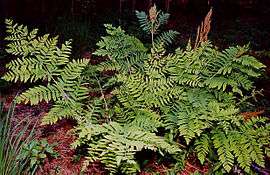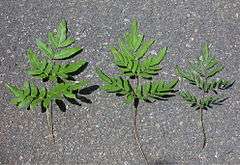Osmunda
Osmunda is a genus of primarily temperate-zone ferns of family Osmundaceae. Five to ten species have been listed for this genus.
| Osmunda | |
|---|---|
 | |
| Osmunda regalis | |
| Scientific classification | |
| Kingdom: | Plantae |
| Clade: | Tracheophytes |
| Class: | Polypodiopsida |
| Order: | Osmundales |
| Family: | Osmundaceae |
| Genus: | Osmunda L. |
| Type species | |
| Osmunda regalis L. | |
| Species | |
|
See text. | |

Description
Completely dimorphic fronds or pinnae (hemidimorphic), green photosynthetic sterile fronds, and non-photosynthetic spore-bearing fertile pinnae, with large, naked sporangia. Because of the large mass of sporangia that ripen uniformly at the same time to a showy golden color, the ferns look as if they are in flower, and so this genus is sometimes called the "flowering ferns".
Taxonomy
Osmunda, the type genus of the fern order, Osmundales has historically been the largest genus in the family Osmundaceae. Smith et al. (2006), who carried out the first higher-level pteridophyte classification published in the molecular phylogenetic era, described three genera in that family, namely Osmunda, Leptopteris, and Todea.[1] The genus has also been treated historically as consisting of a number of subgroups, generally subgenera, Osmunda (3 species), Osmundastrum (2 species), and Plenasium (3–4 species). However, there was suspicion that the genus was not monophyletic.[2]
The publication of a detailed phylogeny of the family by Metzgar et al. in 2008 showed that Osmunda as circumscribed was paraphyletic and that Osmunda cinnamomea, despite its morphological similarity to Osmunda claytoniana, was sister to the rest of the family, and resurrected the segregate genus Osmundastrum, by elevating it from subgenus, to contain it and render Osmunda monophyletic. Their phylogeny of Osmundaceae genera is shown in the following cladogram.[2]
| Osmundaceae |
| ||||||||||||||||||||||||||||||
A number of authors have proposed elevating the subgenera to separate genus level,[2] In 2016 the Pteridophyte Phylogeny Group (PPG) classification split Osmunda further by elevating its subgenera to genera as Claytosmunda and Plenasium, leaving only the species originally included in subgenus Osmunda.[3]
- Osmunda japonica – Japanese flowering fern
- Osmunda lancea – Japanese lancea flowering fern
- Osmunda regalis – Old World royal fern
- Osmunda spectabilis – American royal fern
- †Osmunda wehrii – (Middle Miocene, Washington state)[4]
One extinct species is placed in the genus:
- †Osmunda claytoniites (Phipps et al., 1998)[5]
Hybrids
- Osmunda × ruggii: O. claytoniana × O. spectabilis
- Osmunda × intermedia: O. lancea × O. japonica
- Osmunda mildei: apparently a species, but arising from O. angustifolia × O. japonica
Previously included
The following species actually belong in the separate genus Osmundastrum, even though they have long been regarded as part of Osmunda:
- Osmundastrum asiaticum (syn. Osmunda cinnamomea var. asiatica) – Asian cinnamon fern
- Osmundastrum cinnamomeum – cinnamon fern
Extant species formerly placed in subgenus Claytosmunda are now placed in Claytosmunda in the Pteridophyte Phylogeny Group classification of 2016:[3]:
- Claytosmunda claytoniana – interrupted fern, Clayton's fern
The following species are placed in Plenasium in the Pteridophyte Phylogeny Group classification of 2016:[3]:
- Plenasium angustifolium, syn. Osmunda angustifolia
- Plenasium banksiifolium, syns. Osmunda banksiifolia, Osmunda bromeliifolia
- Plenasium javanicum, syn. Osmunda javanica
- Plenasium vachellii, syn. Osmunda vachellii
Etymology
The derivation of the genus name is uncertain. A leading theory is that it is from an English folk tale of a boatman named Osmund hiding his wife and children in a patch of royal fern during the Danish invasion. Other theories propose that it is from Middle English and Middle French words for a type of fern.
Ecology

Osmunda species are used as food plants by the larvae of some Lepidoptera species including the engrailed.
One of the species, the cinnamon fern (Osmundastrum cinnamomeum) forms huge clonal colonies in swamp areas. These ferns form massive rootstocks with densely matted, wiry roots. This root mass is an excellent substrate for many epiphytal plants. They are often harvested as osmundine and used horticulturally, especially in propagating and growing orchids.
References
- Smith et al. 2006.
- Metzgar et al. 2008.
- Pteridophyte Phylogeny Group 2016.
- Miller, C.N. jr. (1982). "Osmunda wehrii, a New Species Based on Petrified Rhizomes from the Miocene of Washington". American Journal of Botany. 69 (1): 116–121. doi:10.2307/2442836. JSTOR 2442836.
- Thomas N. Taylor, Edith L. Taylor, Michael Krings: Paleobotany. The Biology and Evolution of Fossil Plants . Second Edition, Academic Press 2009, ISBN 978-0-12-373972-8 , p. 437-443
Bibliography
- Chase, Mark W.; Reveal, James L. (2009). "A phylogenetic classification of the land plants to accompany APG III". Botanical Journal of the Linnean Society. 161 (2): 122–127. doi:10.1111/j.1095-8339.2009.01002.x.CS1 maint: ref=harv (link)
- Christenhusz, M. J. M.; Zhang, X. C.; Schneider, H. (18 February 2011). "A linear sequence of extant families and genera of lycophytes and ferns". Phytotaxa. 19 (1): 7. doi:10.11646/phytotaxa.19.1.2.
- Christenhusz, Maarten J.M.; Chase, Mark W. (2014). "Trends and concepts in fern classification". Annals of Botany. 113 (4): 571–594. doi:10.1093/aob/mct299. PMC 3936591. PMID 24532607.CS1 maint: ref=harv (link)
- Christenhusz, Maarten JM & Byng, J. W. (2016). "The number of known plants species in the world and its annual increase". Phytotaxa. 261 (3): 201–217. doi:10.11646/phytotaxa.261.3.1.CS1 maint: ref=harv (link)
- Lehtonen, Samuli (2011). "Towards Resolving the Complete Fern Tree of Life". PLoS ONE. 6 (10): e24851. doi:10.1371/journal.pone.0024851. PMC 3192703. PMID 22022365.CS1 maint: ref=harv (link)
- Metzgar, Jordan S.; Skog, Judith E.; Zimmer, Elizabeth A.; Pryer, Kathleen M. (1 March 2008). "The Paraphyly of Osmunda is Confirmed by Phylogenetic Analyses of Seven Plastid Loci". Systematic Botany. 33 (1): 31–36. doi:10.1600/036364408783887528.
- Pryer, Kathleen M.; Schneider, Harald; Smith, Alan R.; Cranfill, Raymond; Wolf, Paul G.; Hunt, Jeffrey S.; Sipes, Sedonia D. (2001). "Horsetails and ferns are a monophyletic group and the closest living relatives to seed plants". Nature. 409 (6820): 618–622. doi:10.1038/35054555. PMID 11214320.
- Pteridophyte Phylogeny Group (November 2016). "A community-derived classification for extant lycophytes and ferns". Journal of Systematics and Evolution. 54 (6): 563–603. doi:10.1111/jse.12229.CS1 maint: ref=harv (link)
- Ranker, Tom A.; Haufler, Christopher H., eds. (2008). Biology and Evolution of Ferns and Lycophytes. Cambridge University Press. ISBN 978-0-521-87411-3.CS1 maint: ref=harv (link)
- Schneider, Harald; Smith, Alan R.; Pryer, Kathleen M. (1 July 2009). "Is Morphology Really at Odds with Molecules in Estimating Fern Phylogeny?". Systematic Botany. 34 (3): 455–475. doi:10.1600/036364409789271209.
- Smith, Alan R.; Kathleen M. Pryer; Eric Schuettpelz; Petra Korall; Harald Schneider; Paul G. Wolf (2006). "A classification for extant ferns" (PDF). Taxon. 55 (3): 705–731. doi:10.2307/25065646. JSTOR 25065646.
- Smith, Alan R.; Pryer, Kathleen M.; Schuettpelz, Eric; Korall, Petra; Schneider, Harald; Wolf, Paul G. Fern classification (PDF). pp. 417–467., in Ranker & Haufler (2008)
- Phipps, C.J., Taylor, T.N., Taylor, E.L., Cuneo, N.R., Boucher, L.D., and Yao, X. (1998). Osmunda (Osmundaceae) from the Triassic of Antarctica: An example of evolutionary stasis. American Journal of Botany 85: 888-895
External links
| Wikisource has the text of the 1879 American Cyclopædia article Osmunda. |
- Germplasm Resources Information Network: Osmunda
- Flora of North America: Osmunda
- Species list for Osmunda
- http://data.gbif.org/species/browse/taxon/13191108
| Wikimedia Commons has media related to Osmunda. |
| Wikispecies has information related to Osmunda |